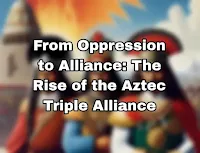How did the Aztec Triple Alliance form?
How did the Aztec Triple Alliance form?
The formation of the Aztec Triple Alliance, a pivotal moment in Mesoamerican history, was a complex interplay of power struggles, alliances, and strategic maneuvering.
The Tepanec Hegemony and Rising Tensions
- Dominant Power: Prior to the Triple Alliance's formation, the Tepanec city of Azcapotzalco held significant influence in the Valley of Mexico, demanding tribute from surrounding city-states, including Tenochtitlan, Texcoco, and Tlacopan.
- Growing Resentment: Over time, Azcapotzalco's oppressive rule and increasing tribute demands fueled resentment and a desire for independence among its tributaries.
- Weakening Power: Internal conflicts and leadership struggles within Azcapotzalco further weakened its grip on the region, creating an opportunity for the other city-states.
The Spark of Rebellion
- Tenochtitlan and Texcoco Unite: In 1426, facing escalating demands and abuses from Azcapotzalco, Tenochtitlan, led by the ambitious ruler Itzcoatl, joined forces with Texcoco, under Nezahualcoyotl, who had been ousted from his throne by the Tepanecs.
- Strategic Alliance: This alliance, driven by a shared desire to overthrow Azcapotzalco and secure their own independence, marked the initial step towards the Triple Alliance.
Conquering Azcapotzalco and Forging the Alliance
- Decisive Victory: In 1428, the combined forces of Tenochtitlan, Texcoco, and additional allies, including Huexotzinco, launched a decisive attack on Azcapotzalco. The Tepanecs were defeated, their capital captured, and their dominance shattered.
- Formalizing the Alliance: Following the victory, the three main victors – Tenochtitlan, Texcoco, and Tlacopan (who had also switched sides during the war) – formalized the Triple Alliance through a treaty.
Structure and Purpose
- Shared Benefits: The alliance aimed to prevent the rise of another dominant power like Azcapotzalco and ensure the collective security and prosperity of its members.
- Military Cooperation: The treaty established a framework for military cooperation, with each member contributing troops to future campaigns undertaken by the alliance.
- Tribute and Spoils: The agreement also dictated the division of spoils and tribute acquired through joint conquests, with Tenochtitlan receiving a larger share due to its greater military contribution.
The Aztec Triple Alliance, born from shared grievances and strategic alliances, went on to become a powerful force in central Mexico, paving the way for the rise of the Aztec Empire.
